Treasury & Risk Management: Currency Exchange and Hedging Analysis
VerifiedAdded on 2021/04/17
|8
|2010
|27
Homework Assignment
AI Summary
This assignment delves into the complexities of currency exchange rate determination, focusing on the role of central banks, particularly the Swiss National Bank (SNB). It examines the SNB's intervention in the currency market, the 2011 pegging of the Swiss Franc to the Euro, and the subsequent de-pegging decision in 2015, driven by factors such as public pressure and the ECB's quantitative easing. The assignment highlights the impact of the de-pegging on Swiss exporters and emphasizes the importance of hedging strategies. It then explores various hedging techniques, including unhedged strategies, forward hedge strategies, money market hedges, and option hedges, providing detailed explanations, calculations, and risk assessments for each. The analysis underscores the effectiveness of different hedging approaches in mitigating currency risk, particularly in the context of fluctuating exchange rates and international trade. The best option would be money market hedge as has been demonstrated with 50 million euros example where the final amount to the exporter in USD is more as compared to a forward contract hedge. Also, option hedge would be useful only when there is significant depreciation of USD against the Euro which may or may not happen.
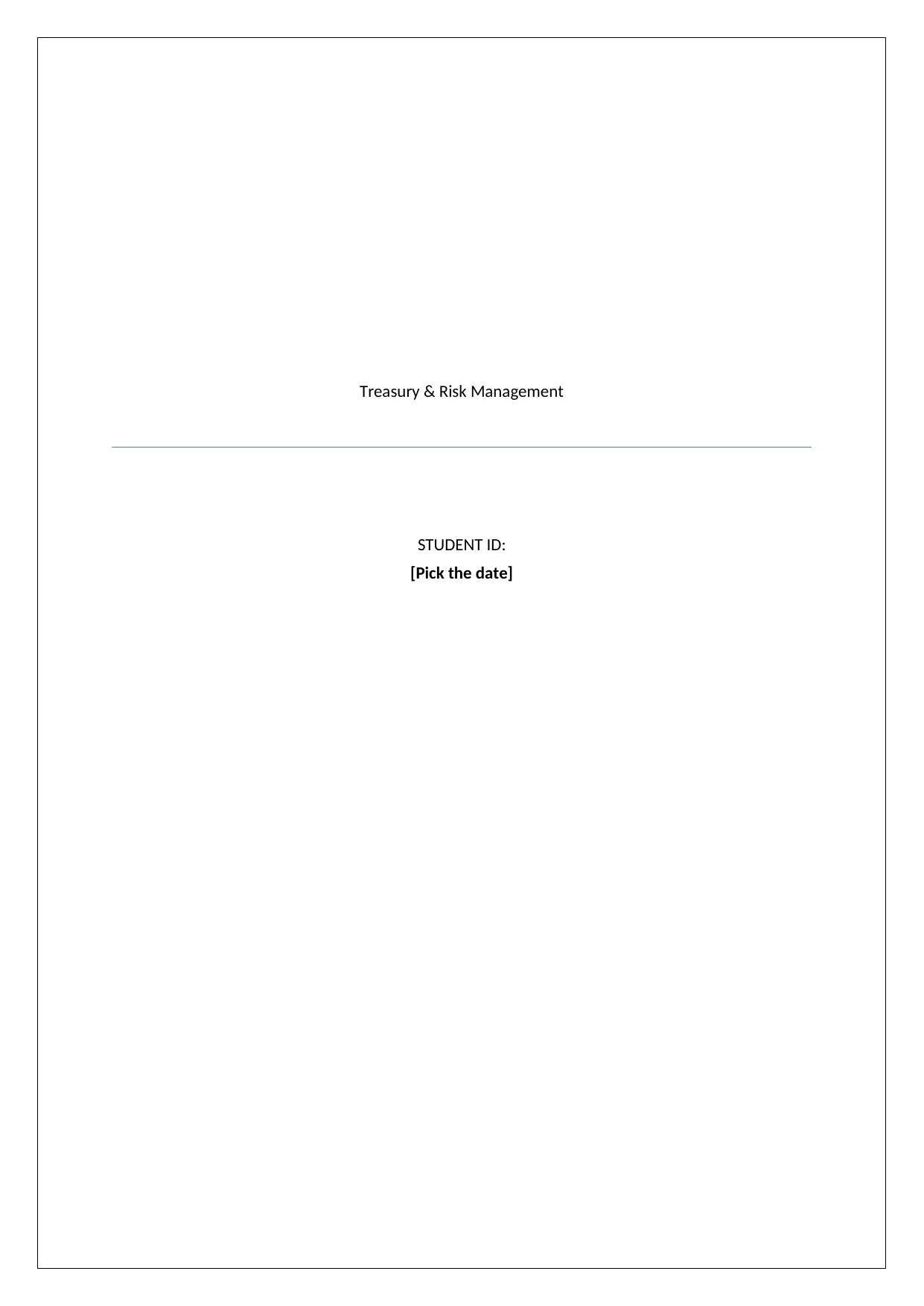
Treasury & Risk Management
STUDENT ID:
[Pick the date]
STUDENT ID:
[Pick the date]
Paraphrase This Document
Need a fresh take? Get an instant paraphrase of this document with our AI Paraphraser
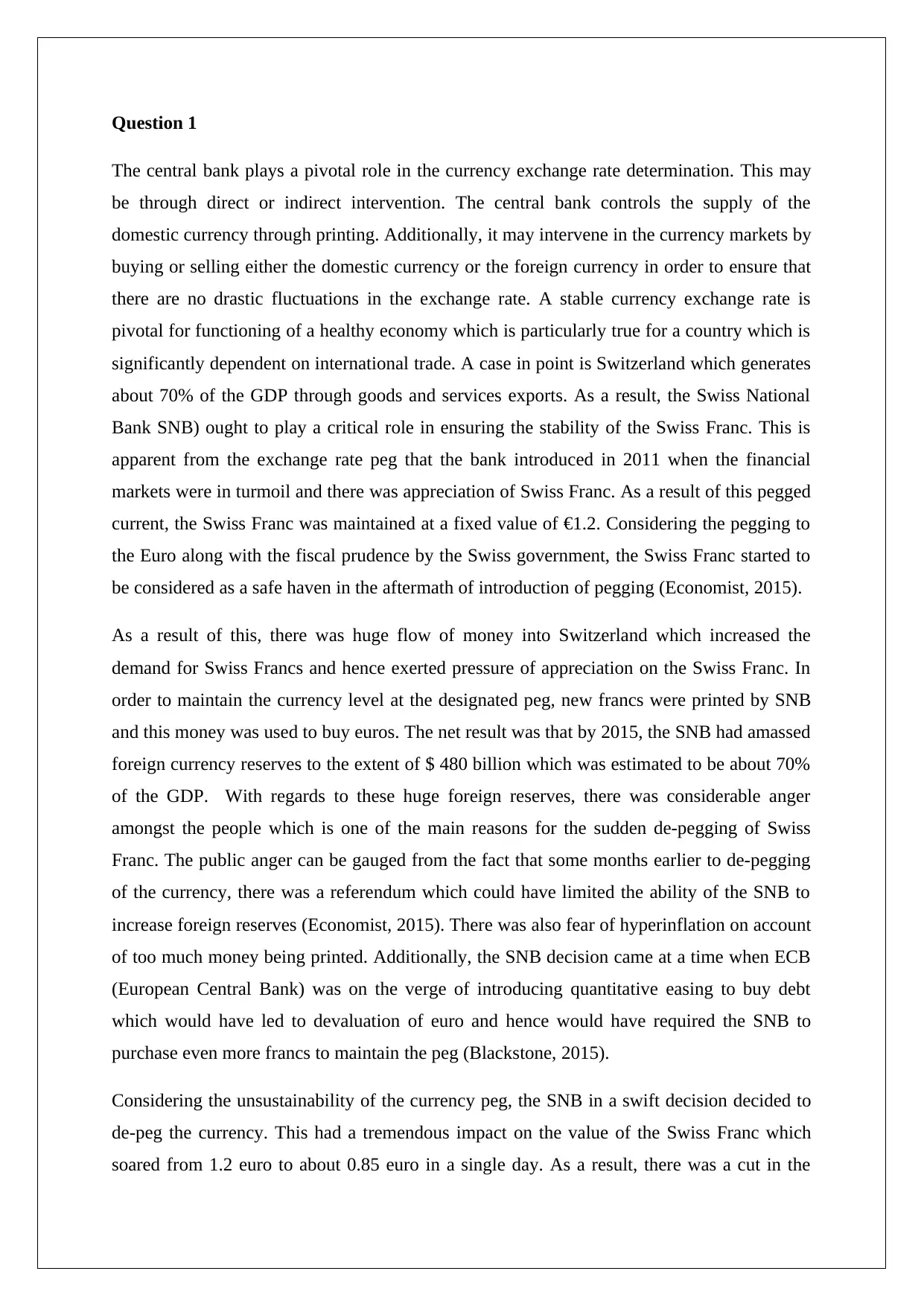
Question 1
The central bank plays a pivotal role in the currency exchange rate determination. This may
be through direct or indirect intervention. The central bank controls the supply of the
domestic currency through printing. Additionally, it may intervene in the currency markets by
buying or selling either the domestic currency or the foreign currency in order to ensure that
there are no drastic fluctuations in the exchange rate. A stable currency exchange rate is
pivotal for functioning of a healthy economy which is particularly true for a country which is
significantly dependent on international trade. A case in point is Switzerland which generates
about 70% of the GDP through goods and services exports. As a result, the Swiss National
Bank SNB) ought to play a critical role in ensuring the stability of the Swiss Franc. This is
apparent from the exchange rate peg that the bank introduced in 2011 when the financial
markets were in turmoil and there was appreciation of Swiss Franc. As a result of this pegged
current, the Swiss Franc was maintained at a fixed value of €1.2. Considering the pegging to
the Euro along with the fiscal prudence by the Swiss government, the Swiss Franc started to
be considered as a safe haven in the aftermath of introduction of pegging (Economist, 2015).
As a result of this, there was huge flow of money into Switzerland which increased the
demand for Swiss Francs and hence exerted pressure of appreciation on the Swiss Franc. In
order to maintain the currency level at the designated peg, new francs were printed by SNB
and this money was used to buy euros. The net result was that by 2015, the SNB had amassed
foreign currency reserves to the extent of $ 480 billion which was estimated to be about 70%
of the GDP. With regards to these huge foreign reserves, there was considerable anger
amongst the people which is one of the main reasons for the sudden de-pegging of Swiss
Franc. The public anger can be gauged from the fact that some months earlier to de-pegging
of the currency, there was a referendum which could have limited the ability of the SNB to
increase foreign reserves (Economist, 2015). There was also fear of hyperinflation on account
of too much money being printed. Additionally, the SNB decision came at a time when ECB
(European Central Bank) was on the verge of introducing quantitative easing to buy debt
which would have led to devaluation of euro and hence would have required the SNB to
purchase even more francs to maintain the peg (Blackstone, 2015).
Considering the unsustainability of the currency peg, the SNB in a swift decision decided to
de-peg the currency. This had a tremendous impact on the value of the Swiss Franc which
soared from 1.2 euro to about 0.85 euro in a single day. As a result, there was a cut in the
The central bank plays a pivotal role in the currency exchange rate determination. This may
be through direct or indirect intervention. The central bank controls the supply of the
domestic currency through printing. Additionally, it may intervene in the currency markets by
buying or selling either the domestic currency or the foreign currency in order to ensure that
there are no drastic fluctuations in the exchange rate. A stable currency exchange rate is
pivotal for functioning of a healthy economy which is particularly true for a country which is
significantly dependent on international trade. A case in point is Switzerland which generates
about 70% of the GDP through goods and services exports. As a result, the Swiss National
Bank SNB) ought to play a critical role in ensuring the stability of the Swiss Franc. This is
apparent from the exchange rate peg that the bank introduced in 2011 when the financial
markets were in turmoil and there was appreciation of Swiss Franc. As a result of this pegged
current, the Swiss Franc was maintained at a fixed value of €1.2. Considering the pegging to
the Euro along with the fiscal prudence by the Swiss government, the Swiss Franc started to
be considered as a safe haven in the aftermath of introduction of pegging (Economist, 2015).
As a result of this, there was huge flow of money into Switzerland which increased the
demand for Swiss Francs and hence exerted pressure of appreciation on the Swiss Franc. In
order to maintain the currency level at the designated peg, new francs were printed by SNB
and this money was used to buy euros. The net result was that by 2015, the SNB had amassed
foreign currency reserves to the extent of $ 480 billion which was estimated to be about 70%
of the GDP. With regards to these huge foreign reserves, there was considerable anger
amongst the people which is one of the main reasons for the sudden de-pegging of Swiss
Franc. The public anger can be gauged from the fact that some months earlier to de-pegging
of the currency, there was a referendum which could have limited the ability of the SNB to
increase foreign reserves (Economist, 2015). There was also fear of hyperinflation on account
of too much money being printed. Additionally, the SNB decision came at a time when ECB
(European Central Bank) was on the verge of introducing quantitative easing to buy debt
which would have led to devaluation of euro and hence would have required the SNB to
purchase even more francs to maintain the peg (Blackstone, 2015).
Considering the unsustainability of the currency peg, the SNB in a swift decision decided to
de-peg the currency. This had a tremendous impact on the value of the Swiss Franc which
soared from 1.2 euro to about 0.85 euro in a single day. As a result, there was a cut in the

economic growth estimate of Switzerland which is expected considering the country’s
excessive reliance on exports (Klein, 2017). The exporters were the worst hit due to this
decision. However, this decision highlighted the need for hedging in wake of increased
currency risk. The hedges deployed by Swiss company can be categorised into two sub-
categories namely natural hedge and financial hedge. Considering the strong Franc, it is
always advantageous for the exporting firms to source various raw materials from outside
Switzerland and pay the suppliers in USD since America is one of the main export
destinations of exporters in Switzerland. This not only lowers the overall cost but also works
as a natural hedge. Besides, financial hedges include foreign currency swaps, derivatives
along with forward agreements. These have been quite effective as various research studies
have indicated that future contracts based in Swiss Francs are highly effective to ward off the
underlying currency risk (Choi, 2009). This is not surprising considering the heavy reliance
on exports in the Swiss economy coupled with the strong inflows in the country which is
always putting an appreciative pressure on the currency. In such an environment, the
exporters need to take various measures to hedge their exports in order to maintain their
underlying competitiveness in the market place (Klein, 2017).
From the above discussion, it is apparent that the main reason behind the de-pegging of Swiss
Franc by the SNB was the unsustainable pumping in of Francs in order to support a weak
euro which led to excessive printing of Swiss Francs coupled with high euro based foreign
currency reserve. The de-pegging of currency proved disastrous for the exporters since the
Swiss Franc appreciated significantly. As a result, various hedging strategies have been
successfully put in place by the exporters and importers in order to minimise the currency
risk through the use of natural and financial hedges. The hedging strategy used has been quite
effective as highlighted in the various research studies.
Question 2
a) (i) Unhedged Strategy
In an unhedged strategy, the exporter would bear all the exchange rate risk owing to the
current fluctuation. If there is appreciation in the USD with regards to Euro, then the net cash
inflow for the exporter would reduce which would adversely impact the profit.
excessive reliance on exports (Klein, 2017). The exporters were the worst hit due to this
decision. However, this decision highlighted the need for hedging in wake of increased
currency risk. The hedges deployed by Swiss company can be categorised into two sub-
categories namely natural hedge and financial hedge. Considering the strong Franc, it is
always advantageous for the exporting firms to source various raw materials from outside
Switzerland and pay the suppliers in USD since America is one of the main export
destinations of exporters in Switzerland. This not only lowers the overall cost but also works
as a natural hedge. Besides, financial hedges include foreign currency swaps, derivatives
along with forward agreements. These have been quite effective as various research studies
have indicated that future contracts based in Swiss Francs are highly effective to ward off the
underlying currency risk (Choi, 2009). This is not surprising considering the heavy reliance
on exports in the Swiss economy coupled with the strong inflows in the country which is
always putting an appreciative pressure on the currency. In such an environment, the
exporters need to take various measures to hedge their exports in order to maintain their
underlying competitiveness in the market place (Klein, 2017).
From the above discussion, it is apparent that the main reason behind the de-pegging of Swiss
Franc by the SNB was the unsustainable pumping in of Francs in order to support a weak
euro which led to excessive printing of Swiss Francs coupled with high euro based foreign
currency reserve. The de-pegging of currency proved disastrous for the exporters since the
Swiss Franc appreciated significantly. As a result, various hedging strategies have been
successfully put in place by the exporters and importers in order to minimise the currency
risk through the use of natural and financial hedges. The hedging strategy used has been quite
effective as highlighted in the various research studies.
Question 2
a) (i) Unhedged Strategy
In an unhedged strategy, the exporter would bear all the exchange rate risk owing to the
current fluctuation. If there is appreciation in the USD with regards to Euro, then the net cash
inflow for the exporter would reduce which would adversely impact the profit.
⊘ This is a preview!⊘
Do you want full access?
Subscribe today to unlock all pages.

Trusted by 1+ million students worldwide
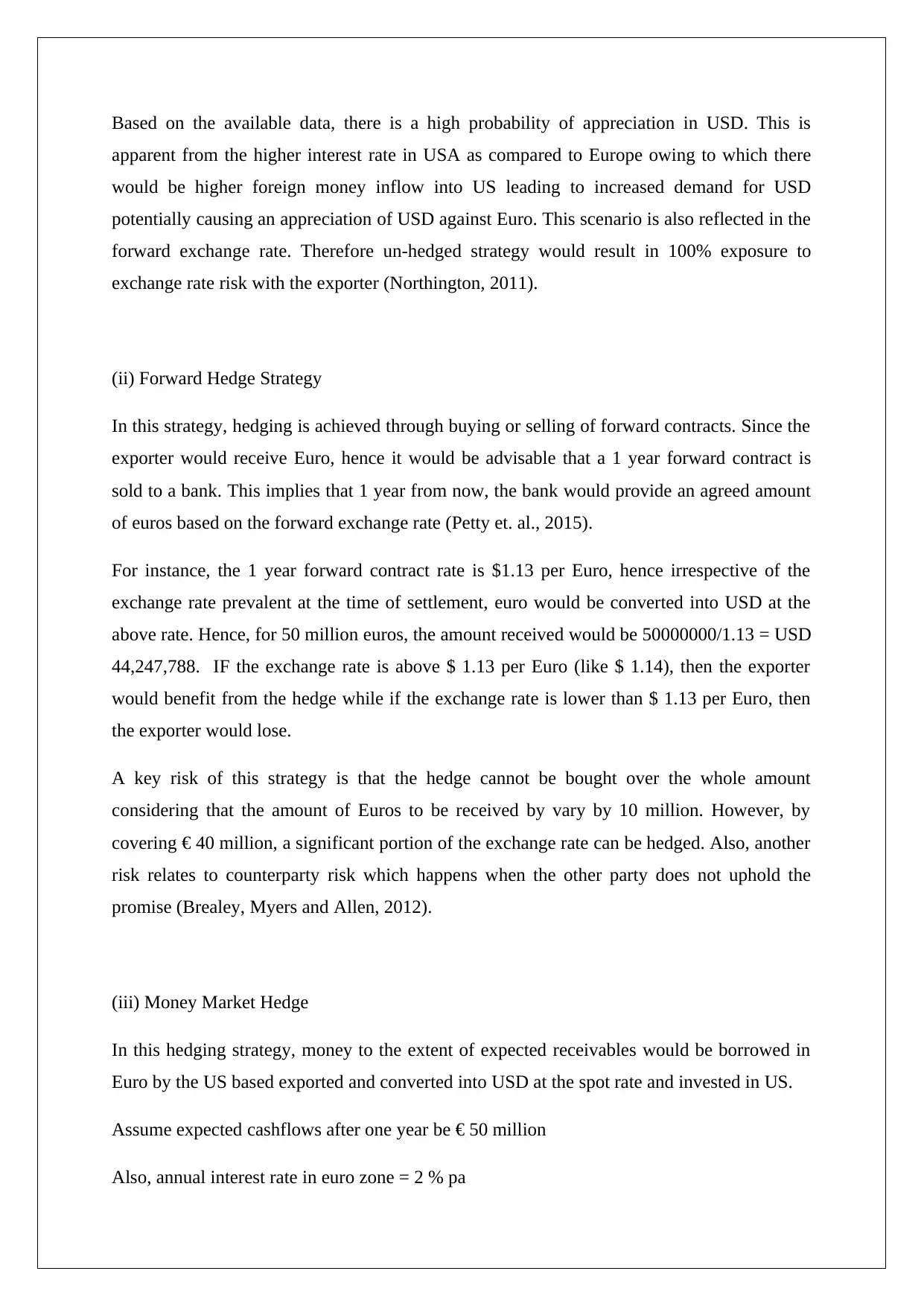
Based on the available data, there is a high probability of appreciation in USD. This is
apparent from the higher interest rate in USA as compared to Europe owing to which there
would be higher foreign money inflow into US leading to increased demand for USD
potentially causing an appreciation of USD against Euro. This scenario is also reflected in the
forward exchange rate. Therefore un-hedged strategy would result in 100% exposure to
exchange rate risk with the exporter (Northington, 2011).
(ii) Forward Hedge Strategy
In this strategy, hedging is achieved through buying or selling of forward contracts. Since the
exporter would receive Euro, hence it would be advisable that a 1 year forward contract is
sold to a bank. This implies that 1 year from now, the bank would provide an agreed amount
of euros based on the forward exchange rate (Petty et. al., 2015).
For instance, the 1 year forward contract rate is $1.13 per Euro, hence irrespective of the
exchange rate prevalent at the time of settlement, euro would be converted into USD at the
above rate. Hence, for 50 million euros, the amount received would be 50000000/1.13 = USD
44,247,788. IF the exchange rate is above $ 1.13 per Euro (like $ 1.14), then the exporter
would benefit from the hedge while if the exchange rate is lower than $ 1.13 per Euro, then
the exporter would lose.
A key risk of this strategy is that the hedge cannot be bought over the whole amount
considering that the amount of Euros to be received by vary by 10 million. However, by
covering € 40 million, a significant portion of the exchange rate can be hedged. Also, another
risk relates to counterparty risk which happens when the other party does not uphold the
promise (Brealey, Myers and Allen, 2012).
(iii) Money Market Hedge
In this hedging strategy, money to the extent of expected receivables would be borrowed in
Euro by the US based exported and converted into USD at the spot rate and invested in US.
Assume expected cashflows after one year be € 50 million
Also, annual interest rate in euro zone = 2 % pa
apparent from the higher interest rate in USA as compared to Europe owing to which there
would be higher foreign money inflow into US leading to increased demand for USD
potentially causing an appreciation of USD against Euro. This scenario is also reflected in the
forward exchange rate. Therefore un-hedged strategy would result in 100% exposure to
exchange rate risk with the exporter (Northington, 2011).
(ii) Forward Hedge Strategy
In this strategy, hedging is achieved through buying or selling of forward contracts. Since the
exporter would receive Euro, hence it would be advisable that a 1 year forward contract is
sold to a bank. This implies that 1 year from now, the bank would provide an agreed amount
of euros based on the forward exchange rate (Petty et. al., 2015).
For instance, the 1 year forward contract rate is $1.13 per Euro, hence irrespective of the
exchange rate prevalent at the time of settlement, euro would be converted into USD at the
above rate. Hence, for 50 million euros, the amount received would be 50000000/1.13 = USD
44,247,788. IF the exchange rate is above $ 1.13 per Euro (like $ 1.14), then the exporter
would benefit from the hedge while if the exchange rate is lower than $ 1.13 per Euro, then
the exporter would lose.
A key risk of this strategy is that the hedge cannot be bought over the whole amount
considering that the amount of Euros to be received by vary by 10 million. However, by
covering € 40 million, a significant portion of the exchange rate can be hedged. Also, another
risk relates to counterparty risk which happens when the other party does not uphold the
promise (Brealey, Myers and Allen, 2012).
(iii) Money Market Hedge
In this hedging strategy, money to the extent of expected receivables would be borrowed in
Euro by the US based exported and converted into USD at the spot rate and invested in US.
Assume expected cashflows after one year be € 50 million
Also, annual interest rate in euro zone = 2 % pa
Paraphrase This Document
Need a fresh take? Get an instant paraphrase of this document with our AI Paraphraser
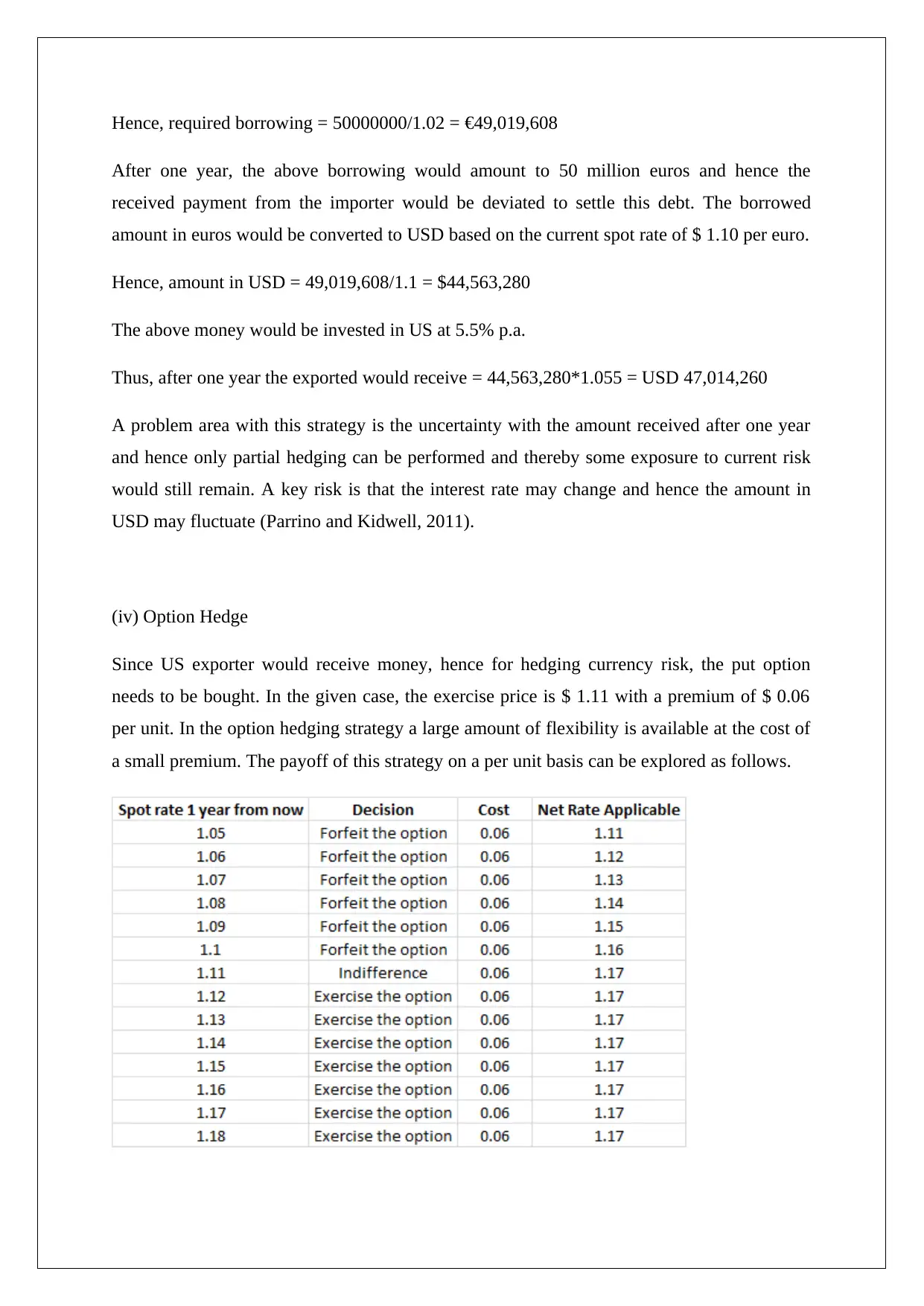
Hence, required borrowing = 50000000/1.02 = €49,019,608
After one year, the above borrowing would amount to 50 million euros and hence the
received payment from the importer would be deviated to settle this debt. The borrowed
amount in euros would be converted to USD based on the current spot rate of $ 1.10 per euro.
Hence, amount in USD = 49,019,608/1.1 = $44,563,280
The above money would be invested in US at 5.5% p.a.
Thus, after one year the exported would receive = 44,563,280*1.055 = USD 47,014,260
A problem area with this strategy is the uncertainty with the amount received after one year
and hence only partial hedging can be performed and thereby some exposure to current risk
would still remain. A key risk is that the interest rate may change and hence the amount in
USD may fluctuate (Parrino and Kidwell, 2011).
(iv) Option Hedge
Since US exporter would receive money, hence for hedging currency risk, the put option
needs to be bought. In the given case, the exercise price is $ 1.11 with a premium of $ 0.06
per unit. In the option hedging strategy a large amount of flexibility is available at the cost of
a small premium. The payoff of this strategy on a per unit basis can be explored as follows.
After one year, the above borrowing would amount to 50 million euros and hence the
received payment from the importer would be deviated to settle this debt. The borrowed
amount in euros would be converted to USD based on the current spot rate of $ 1.10 per euro.
Hence, amount in USD = 49,019,608/1.1 = $44,563,280
The above money would be invested in US at 5.5% p.a.
Thus, after one year the exported would receive = 44,563,280*1.055 = USD 47,014,260
A problem area with this strategy is the uncertainty with the amount received after one year
and hence only partial hedging can be performed and thereby some exposure to current risk
would still remain. A key risk is that the interest rate may change and hence the amount in
USD may fluctuate (Parrino and Kidwell, 2011).
(iv) Option Hedge
Since US exporter would receive money, hence for hedging currency risk, the put option
needs to be bought. In the given case, the exercise price is $ 1.11 with a premium of $ 0.06
per unit. In the option hedging strategy a large amount of flexibility is available at the cost of
a small premium. The payoff of this strategy on a per unit basis can be explored as follows.
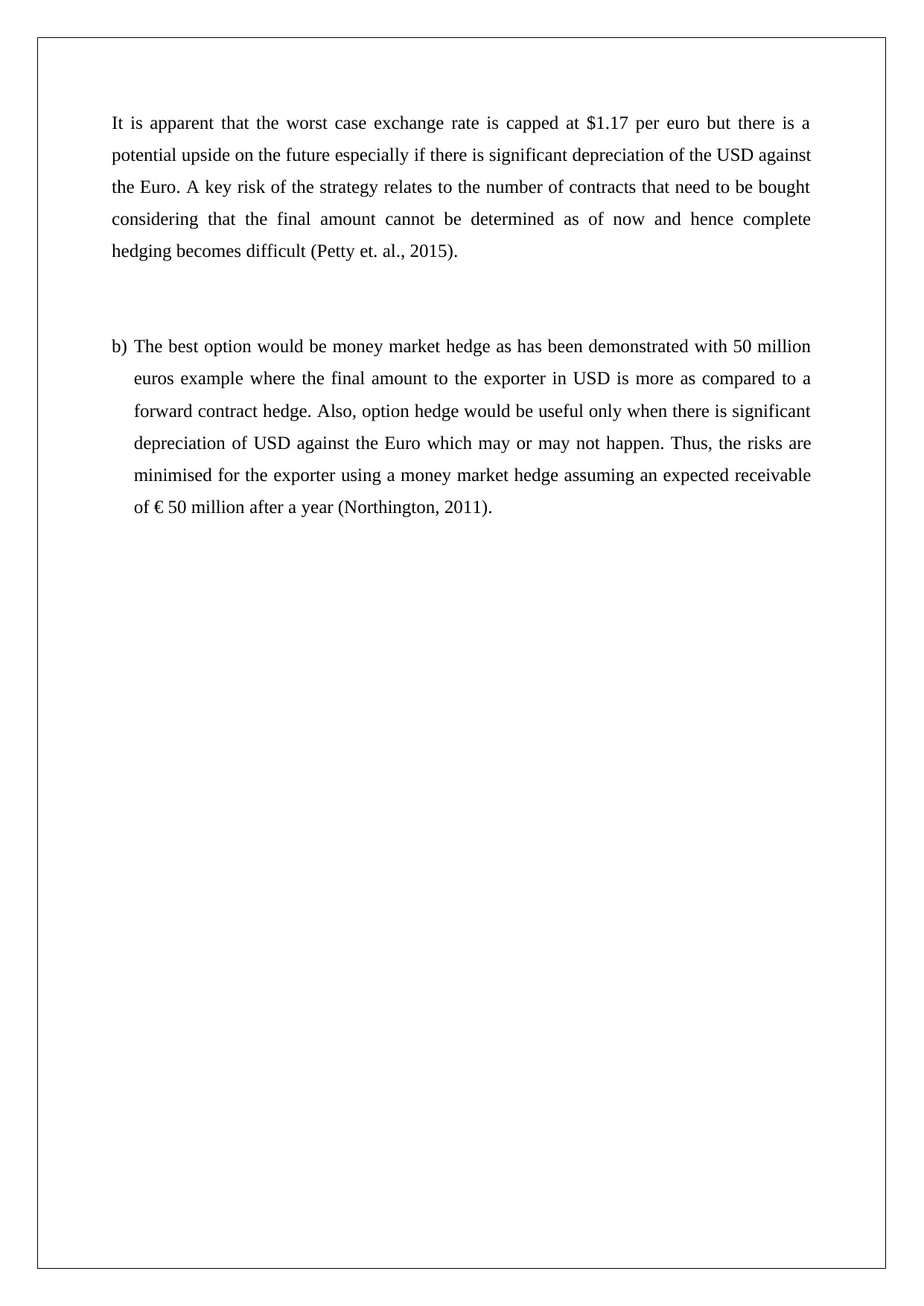
It is apparent that the worst case exchange rate is capped at $1.17 per euro but there is a
potential upside on the future especially if there is significant depreciation of the USD against
the Euro. A key risk of the strategy relates to the number of contracts that need to be bought
considering that the final amount cannot be determined as of now and hence complete
hedging becomes difficult (Petty et. al., 2015).
b) The best option would be money market hedge as has been demonstrated with 50 million
euros example where the final amount to the exporter in USD is more as compared to a
forward contract hedge. Also, option hedge would be useful only when there is significant
depreciation of USD against the Euro which may or may not happen. Thus, the risks are
minimised for the exporter using a money market hedge assuming an expected receivable
of € 50 million after a year (Northington, 2011).
potential upside on the future especially if there is significant depreciation of the USD against
the Euro. A key risk of the strategy relates to the number of contracts that need to be bought
considering that the final amount cannot be determined as of now and hence complete
hedging becomes difficult (Petty et. al., 2015).
b) The best option would be money market hedge as has been demonstrated with 50 million
euros example where the final amount to the exporter in USD is more as compared to a
forward contract hedge. Also, option hedge would be useful only when there is significant
depreciation of USD against the Euro which may or may not happen. Thus, the risks are
minimised for the exporter using a money market hedge assuming an expected receivable
of € 50 million after a year (Northington, 2011).
⊘ This is a preview!⊘
Do you want full access?
Subscribe today to unlock all pages.

Trusted by 1+ million students worldwide
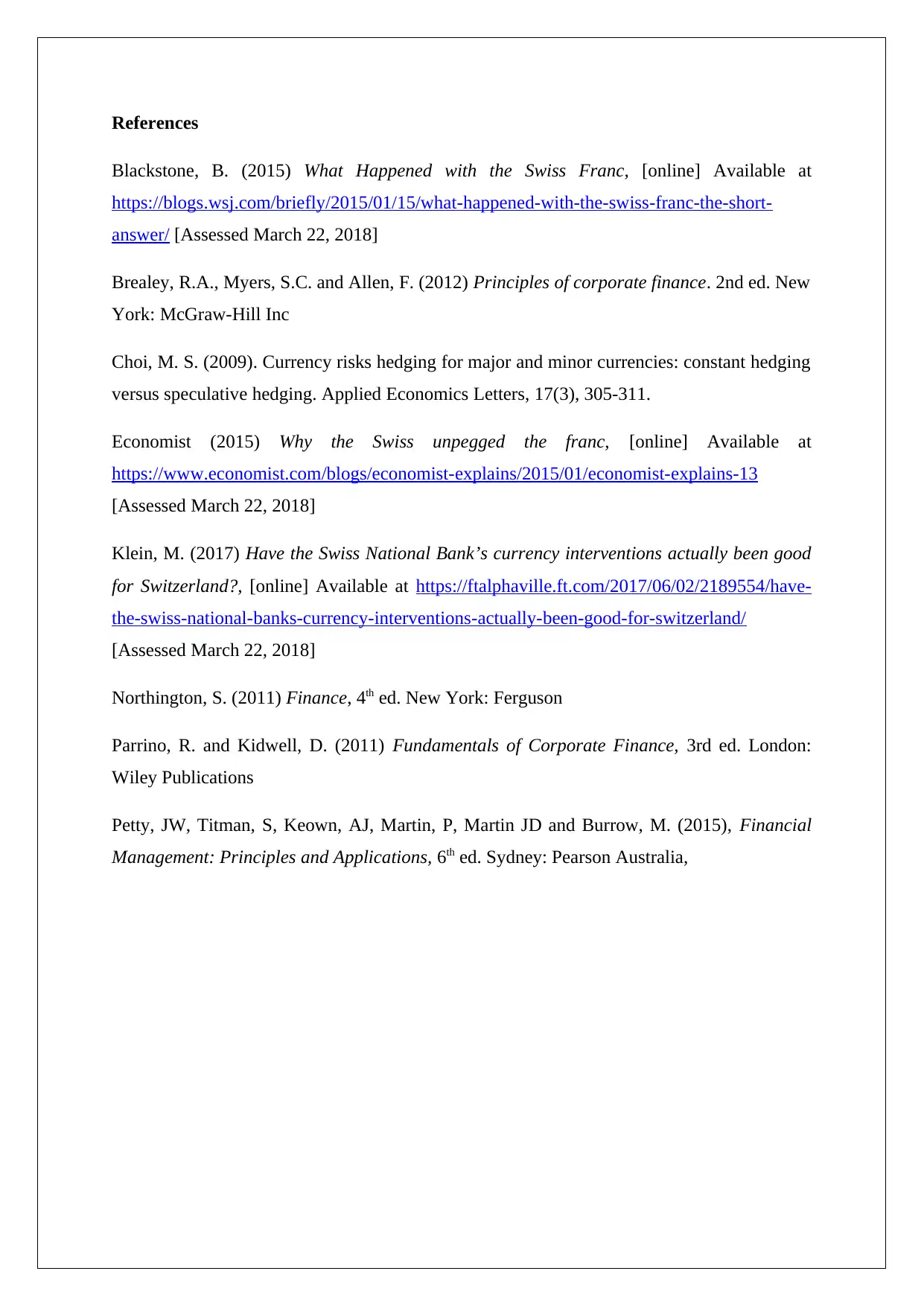
References
Blackstone, B. (2015) What Happened with the Swiss Franc, [online] Available at
https://blogs.wsj.com/briefly/2015/01/15/what-happened-with-the-swiss-franc-the-short-
answer/ [Assessed March 22, 2018]
Brealey, R.A., Myers, S.C. and Allen, F. (2012) Principles of corporate finance. 2nd ed. New
York: McGraw-Hill Inc
Choi, M. S. (2009). Currency risks hedging for major and minor currencies: constant hedging
versus speculative hedging. Applied Economics Letters, 17(3), 305-311.
Economist (2015) Why the Swiss unpegged the franc, [online] Available at
https://www.economist.com/blogs/economist-explains/2015/01/economist-explains-13
[Assessed March 22, 2018]
Klein, M. (2017) Have the Swiss National Bank’s currency interventions actually been good
for Switzerland?, [online] Available at https://ftalphaville.ft.com/2017/06/02/2189554/have-
the-swiss-national-banks-currency-interventions-actually-been-good-for-switzerland/
[Assessed March 22, 2018]
Northington, S. (2011) Finance, 4th ed. New York: Ferguson
Parrino, R. and Kidwell, D. (2011) Fundamentals of Corporate Finance, 3rd ed. London:
Wiley Publications
Petty, JW, Titman, S, Keown, AJ, Martin, P, Martin JD and Burrow, M. (2015), Financial
Management: Principles and Applications, 6th ed. Sydney: Pearson Australia,
Blackstone, B. (2015) What Happened with the Swiss Franc, [online] Available at
https://blogs.wsj.com/briefly/2015/01/15/what-happened-with-the-swiss-franc-the-short-
answer/ [Assessed March 22, 2018]
Brealey, R.A., Myers, S.C. and Allen, F. (2012) Principles of corporate finance. 2nd ed. New
York: McGraw-Hill Inc
Choi, M. S. (2009). Currency risks hedging for major and minor currencies: constant hedging
versus speculative hedging. Applied Economics Letters, 17(3), 305-311.
Economist (2015) Why the Swiss unpegged the franc, [online] Available at
https://www.economist.com/blogs/economist-explains/2015/01/economist-explains-13
[Assessed March 22, 2018]
Klein, M. (2017) Have the Swiss National Bank’s currency interventions actually been good
for Switzerland?, [online] Available at https://ftalphaville.ft.com/2017/06/02/2189554/have-
the-swiss-national-banks-currency-interventions-actually-been-good-for-switzerland/
[Assessed March 22, 2018]
Northington, S. (2011) Finance, 4th ed. New York: Ferguson
Parrino, R. and Kidwell, D. (2011) Fundamentals of Corporate Finance, 3rd ed. London:
Wiley Publications
Petty, JW, Titman, S, Keown, AJ, Martin, P, Martin JD and Burrow, M. (2015), Financial
Management: Principles and Applications, 6th ed. Sydney: Pearson Australia,
Paraphrase This Document
Need a fresh take? Get an instant paraphrase of this document with our AI Paraphraser

1 out of 8
Related Documents
Your All-in-One AI-Powered Toolkit for Academic Success.
+13062052269
info@desklib.com
Available 24*7 on WhatsApp / Email
![[object Object]](/_next/static/media/star-bottom.7253800d.svg)
Unlock your academic potential
Copyright © 2020–2025 A2Z Services. All Rights Reserved. Developed and managed by ZUCOL.




